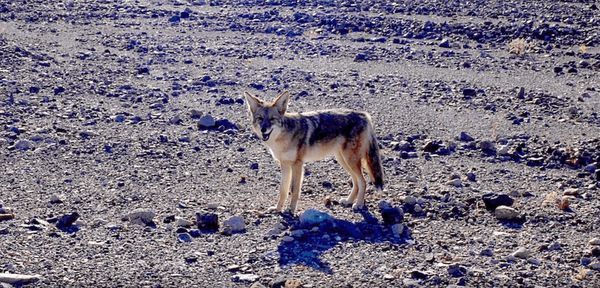Eye For Film >> Movies >> I See A Darkness (2023) Film Review
I See A Darkness
Reviewed by: Jennie Kermode

When we look at the history of cinema, what do we see? That’s a more complex question than it might at first appear to be. We need to acknowledge that it begins not with cinema itself, but with photography, and that the transition from photography to film was not a straightforward one. We might also recognise that we all see things in different ways, so that framing them through a single gaze is immediately political; and that we share the world with many different animals who have their own ways of seeing and interpreting what they see. The sublime cinematic journey created by Fergus Daly and Katherine Waugh addresses all these complexities and more, as it explores this history in relation to the technology that enabled it, observing the many different ways in which the story could have unfolded and prompting us to wonder how different our cultures might have been as a result.
I See A Darkness screened as part of Docs Ireland 2024. There’s an obvious thematic Irish connection in its focus on Lucien Bull, whose chrono-photography linked together still images at very high speeds and took us a step beyond the zoetrope into the realm where cinema began to emerge. Étienne-Jules Marey’s contributions to this art, and its relationship to his attempt to explore movement through superimposition – something which arguably has its roots in prehistory and the art found in the Chauvet caves – are also explored, along with the stroboscope of Harold Edgerton (people with a sensitivity to flashing lights will, sadly, have to avoid the film in its current form). Edgerton’s relationship with Jacques Cousteau and the new visions they brought back from beneath the waves, profoundly changing the way ordinary people understood the world, provides another interesting avenue.
Early on, we find ourselves at the intersection of many different roads, and viewers may be forgiven for feeling a little confused as they wonder where they’re going to find themselves travelling next, yet Daly and Waugh are confident at the wheel – what they gradually reveal is how many of these roads loop back to the others, even as we catch glimpses of abandoned routes leading off to unknown horizons. There is a willful experimentalism at the core of the film, an invitation to look and look again until the familiar becomes strange, until one notices something different. Although a number of philosophers share their thoughts, non-academic viewers will not find themselves excluded, however. Ideas are introduced in a broadly accessible way, and accompanied by beautiful and unusual imagery.
As you might expect, this includes observation of how some of the imagery is made. A sojourn with soap bubbles is an unexpectedly seductive highlight. You might find yourself wondering where some of the more delightful techniques have gone, which is part of the point, as the film gradually reveals how much has been set aside in order to streamline and simplify a form of film which neatly fit into industrial, capitalist objectives. Today, cinema, and its little cousin television, teach us how to look. Daly and Waugh aim to make us aware of that process so that we are empowered to re-envision the world in different ways. They are largely successful, but the real question, of course, is how many viewers will make the effort to keep looking. This film is not a complete journey in itself, but an invitation to set out along those different roads with or without a guide.
It’s not always an easy watch. The darkness within it is plentiful. What viewers will probably struggle with most are the various images of animal cruelty. They have an important place in the story of cinema, however, and carry a necessary weight here. It’s one thing to be told about the famous early short Electrocution Of An Elephant, another to see it: Topsy, who looks as if she’s only in her teens, chained at the ankle, mildly curious but unalarmed as she allows herself to be led through the crowd to the place where death awaits her. The suddenness of it, the unnatural ways she falls. All of the people there who watch as if she were no more than an object, incapable of looking back. We need to see this to understand what will come after.
What is film but the interplay of light and shadow? The same technologies played a role in the embrace of that most terrible light, atomic radiation. We see the animals packed into cages at the Nevada test site with a bank of 200 specially made cameras set to go off in sequence. Later, the people of Nagasaki reduced to photographs by the atomic bomb. A man with a ladder was there when it happened, and no-one would have remembered such a moment until his shadow was burned onto the wall behind him, his flesh and bone evaporated. He’s just one of many – and we see him, we see all of this, through a form of the same medium.
We see the world that way today. No more, in most places, the lion, tiger and two bears in tiny zoo cages as we are presented with them here, a lucrative asset when that was the only way for people to observe them. There is a question in these final images, however. With nothing else to do, these animals are looking back. What do they see? There is no hint of Ted Hughes’ jaguar, the world at large in its mind’s eye. There is, perhaps, curiosity, condemnation, or identification. What we observe can change our perception of ourselves. I See A Darkness offers viewers the chance to look within as well as without.
Reviewed on: 20 Jun 2024













